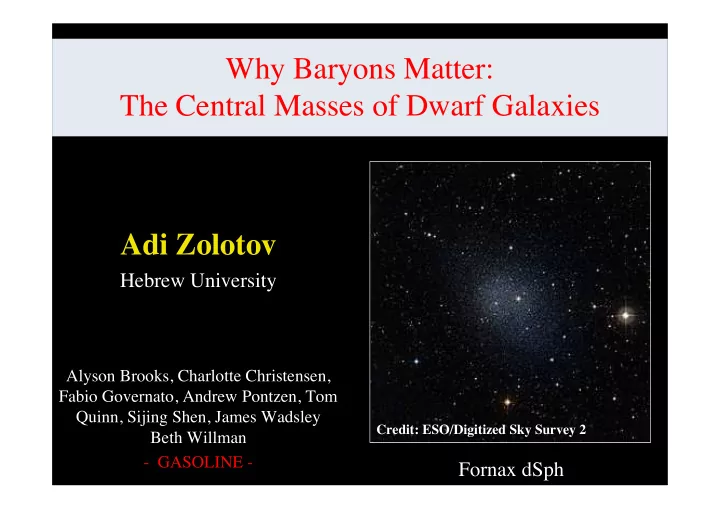

Why Baryons Matter: The Central Masses of Dwarf Galaxies Adi Zolotov Hebrew University Alyson Brooks, Charlotte Christensen, Fabio Governato, Andrew Pontzen, Tom Quinn, Sijing Shen, James Wadsley Credit: ESO/Digitized Sky Survey 2 Beth Willman - GASOLINE - Fornax dSph
I. A challenge to CDM? DM cores Supernova Driven Outflows? ρ∝ r α ρ∝ Oh et al. (2011)
Resolving hi-density SF regions Ceverino & Klypin (2009) Brook et al. (2011) ρ x
Cusp/Core Problem Star formation must be episodic See also: Dekel & Silk (1986) Navarro et al (1996) Read & Gilmore (2005) Pontzen & Governato (2012) Mashchenko et al. (2008), Teyssier et al. (2012) + …
Cusp/Core Problem Isolated field Galaxies with M * > 10 7 Msun have shallow DM profiles MW classical dSph Low luminosity field dwarfs have cusps? Cores in central unresolved regions? Governato, Zolotov, et al. (2012)
II. Another challenge to CDM: Massive Failures CDM subhalos Moore et al. (1999) Klypin et al. (1999) MW dSph Boylan-Kolchin et al. (2011, 2012)
II. A challenge to CDM: Massive Failures Two MW-mass galaxies (M vir ~ 7 - 8 x10 11 ) DM-only vs DM + baryons 1. Find all satellites at z=0 in SPH run 2. Match to satellites in DM-only run at hi-z & infall & z=0 3. Compare density& mass at hi-z, at infall, and at z=0 between DM-only and DM+baryon sats Zolotov, Brooks, et al. (2012) Brooks & Zolotov (2012)
1st Regime: Before Infall The most luminous satellites experience a reduction of 2 - 16 km/s in the central DM Vc due to SNe feedback Zolotov et al. (2012)
Before Infall: SNe Feedback DM-only Weisz et al. (2012) - Dwarfs with M * < 10 7 M DM+baryons are consistent with bursty SFHs Zolotov et al. (2012)
2nd Regime: After Infall Only SPH satellites lose more than 90% of initial mass -> some satellites lose stars as well Only SPH satellites undergo a reduction of more than 40 % in central Vc Due to baryonic disk+ DM density profile Bound mass fraction Zolotov et al. (2012)
2nd Regime: After Infall Cusp Core γ =1.0 γ = 0.0 Penarrubia et al. (2010) No Disk M_disk = 0.1Mvir Disk presence results in more mass loss at each pericentric passage for all satellites This effect is even stronger for cored satellites
After Infall: Tidal stripping Satellite with DM cusp Satellite with DM cusp core Disk effect: DM +baryon sat lost ~ 12% more mass Disk + core effect: DM +baryon sat lost ~ 23% more mass
The Big Picture Most Luminous satellites at infall Most massive DM subhalos at infall
The Big Picture Abundance matching works The central DM masses at × z = 0, however, do not match between satellites with baryons and DM- only satellites There is also gas loss and × stellar mass loss in SPH satellites…
Summary Including baryons in cosmological simulations alleviates some of the tension between predictions of CDM model and observations of galaxies Supernova feedback in simulations that resolve high- density SF peaks naturally result in the flattening of DM cores into cusps (M * > 10^7 Msun) This is true for both field galaxies. For satellites, this results in *reduced* DM densities Tides result in more mass loss at pericentric passage for all satellites in simulations with baryons (baryonic disk + DM core in satellites)
Baryons Matter!
Recommend
More recommend